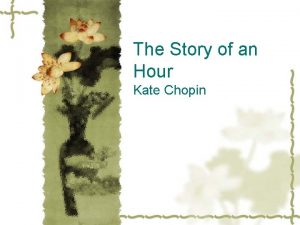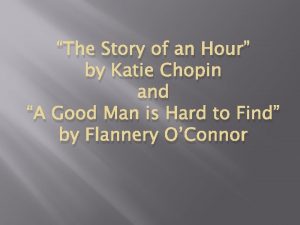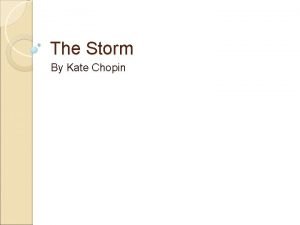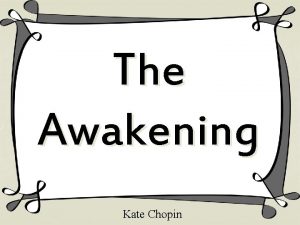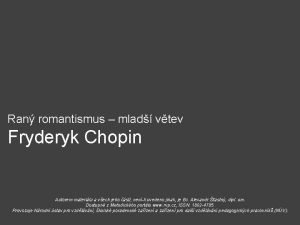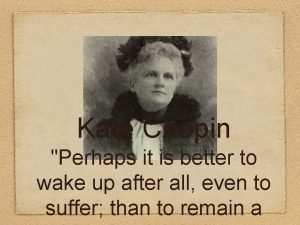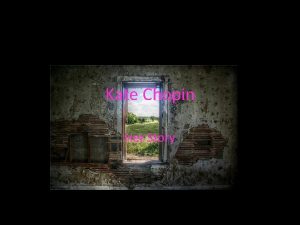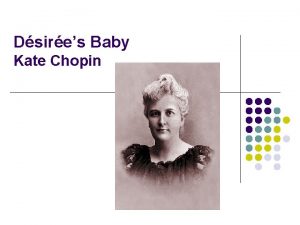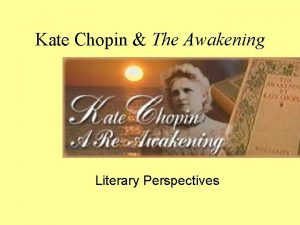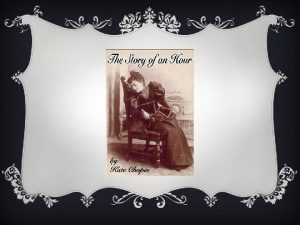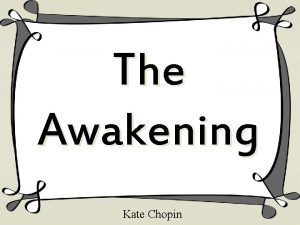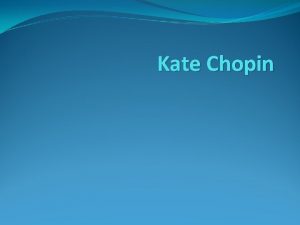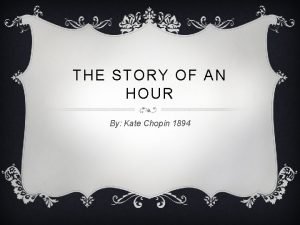The Story of an Hour Kate Chopin The












- Slides: 12

The Story of an Hour Kate Chopin

The Story of an Hour Kate Chopin

The Story of an Hour Kate Chopin v Title The title of the short story refers to the time elapsed between the moments at which the protagonist, Louise Mallard, hears that her husband is dead and discovers that he is alive after all. The Story of an Hour was considered controversial during the 1890 s because it deals with a female protagonist who feels liberated by the news of her husband's death. In Unveiling Kate Chopin, Emily Toth argues that Chopin "had to have heroine die" in order to make the story publishable.

The Story of an Hour Kate Chopin v Characters Mrs. Louise Mallard is the protagonist of the story. She is introduced as being "afflicted with a heart trouble", which is why great care is taken in telling her of her husband's death. She mourns her husband, but then begins to feel relieved and liberated. Mr. Brently Mallard is assumed dead until the end of the story when it is revealed that the news of his death was a mistake.

The Story of an Hour Kate Chopin v Characters Josephine is Louise's sister who tells Louise of her husband's death. She embodies the feminine ideals of the time, acting as the picture perfect wife figure. Richards represents the standard image and expectations of the man during the time period - responsible for protecting women. However, he fails which could have been a bit controversial for the time period.

The Story of an Hour Kate Chopin v Tone An ironically detached and melancholy tone: The story comes off as subtly cruel in that Louise's reaction to the death of her husband was not one of sadness from loss but rather a bitter joy she feels when she comes to the understanding that she is now free from the shackles of marriage, his perceived death representing freedom and independence from the role she is forever bound to by society - a wife.

The Story of an Hour Kate Chopin v Third-person narrative The non-participant narrator provides access to Mrs. Mallard's life: her medical condition or state, her strict marriage, her lackluster relationship with her husband, her perspective on "love" she has for her husband, and her perspective on her newly awakened ideas on her personal freedom—which she associates with the death of her husband.

The Story of an Hour Kate Chopin v Characterization Kate Chopin brought attention to the racial issues that existed during the times of slavery and introduced the two main characters in the story, Désirée and Armand, and creates many symbolisms, ironies, and themes seen throughout the story.

The Story of an Hour Kate Chopin v Marriage vs. Freedom Mrs. Mallard believes that both women and men limit each other in matrimony. The story is not about the husband being abusive to his wife or vice-versa. Instead, it focuses on the individual's inner desires for freedom. Louise's desire for freedom far exceeds her love for him - a controversial idea that goes against the norms of society.

The Story of an Hour Kate Chopin v Symbolism Spring –This symbolizes a new beginning which represents life and that is what Mrs. Mallard gains as a widow. It also helps to note that spring comes after winter. Mrs. Mallard’s Heart: She dies of heart failure triggered by overwhelming emotional stress. No one will ever know that the overwhelming emotional stress was due to her loss of hope for the future.

The Story of an Hour Kate Chopin v Women's Liberation Movement In the story, this housewife who has been confined to the social norms of the obedient wife, has an unorthodox reaction to the death of her husband. She anticipates her newfound freedom from the suppression of her husband, of men, and becomes invigorated by it. This idea is one of the key values of the feminist movement, and thus "The Story of an Hour" was an important literary work to show a woman breaking from the norm of society.

The Story of an Hour Kate Chopin v Film Adaptation The Joy that Kills, 1984 film adaptation, directed by Tina Rathbone. It was released in 1984 as part of the PBS series American Playhouse.
 The theme of the story of an hour
The theme of the story of an hour What does music symbolize in the awakening
What does music symbolize in the awakening Kate chopin accomplishments
Kate chopin accomplishments Facts about kate chopin
Facts about kate chopin 2nd great awakening apush
2nd great awakening apush Desirees baby kate chopin
Desirees baby kate chopin How to pronounce kate chopin
How to pronounce kate chopin The storm by kate chopin
The storm by kate chopin The awakening kate chopin synopsis
The awakening kate chopin synopsis Storm kate chopin
Storm kate chopin Kate chopin facts
Kate chopin facts Erratic
Erratic Kate del castillo negrete trillo
Kate del castillo negrete trillo
